Southeast Asia Hydrogen Generation Market Size
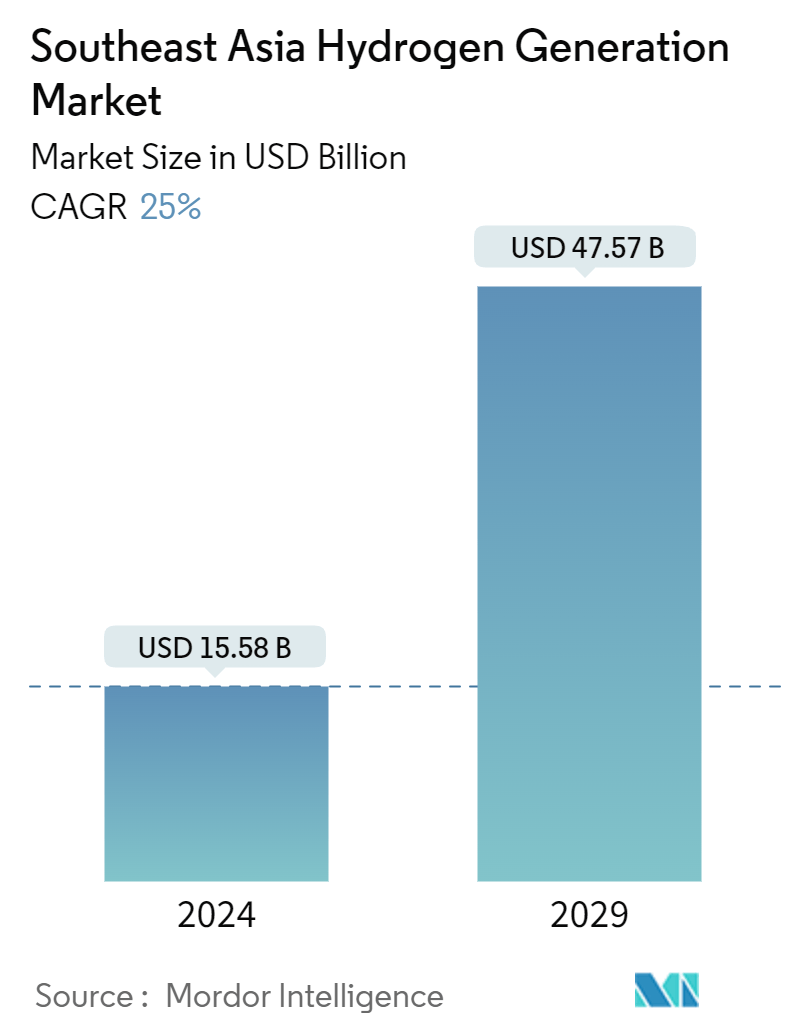
| Study Period | 2019 - 2029 |
| Base Year For Estimation | 2023 |
| Market Size (2024) | USD 15.58 Billion |
| Market Size (2029) | USD 47.57 Billion |
| CAGR (2024 - 2029) | 25.00 % |
| Market Concentration | High |
Major Players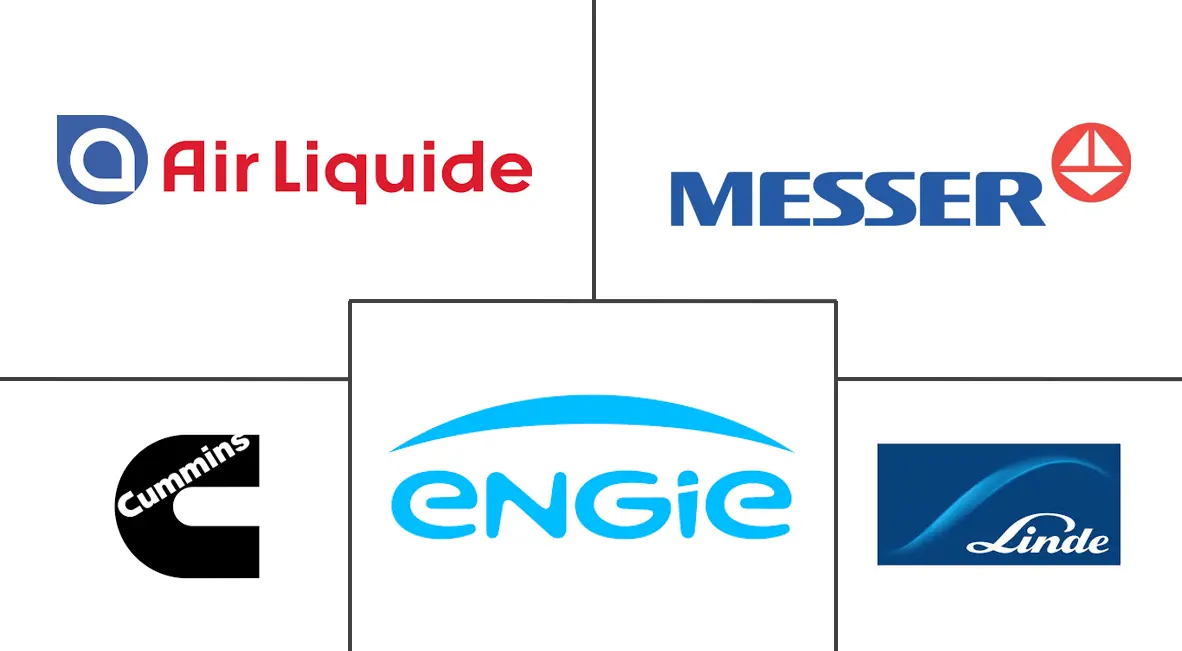
*Disclaimer: Major Players sorted in no particular order |
Southeast Asia Hydrogen Generation Market Analysis
The Southeast Asia Hydrogen Generation Market size is estimated at USD 15.58 billion in 2024, and is expected to reach USD 47.57 billion by 2029, growing at a CAGR of 25% during the forecast period (2024-2029).
• Over the medium term, factors such as increased government regulations for desulphurization, greenhouse gas emissions, and encouraging the production and consumption of hydrogen are likely to drive the hydrogen generation market in the Southeast Asian region during the forecast period.
• On the other hand, the high capital costs of hydrogen energy storage are expected to restrain the growth of hydrogen generation.
• Nevertheless, technological advancements in extracting hydrogen from renewable sources and increased applications of hydrogen as a fuel are likely to create lucrative growth opportunities for the hydrogen generation market in the coming years.
• Indonesia is expected to witness significant growth in the Southeast Asian hydrogen generation market during the forecast period.
Southeast Asia Hydrogen Generation Market Trends
Grey Hydrogen is a Significant Segment
- Grey hydrogen is the most common form of hydrogen production, and it uses natural gas (via stream methane reformation) or coal (via coal gasification) to produce hydrogen. The process of hydrogen production is a carbon-intensive process, as significant carbon emissions are released into the atmosphere during these production processes.
- According to the Global CCS Institute, approximately 120 Mt of hydrogen is produced annually, of which approximately 98% of current hydrogen production is from the reformation of methane or the gasification of coal or similar materials of fossil-fuel origin (e.g., petcokeor asphaltene). A similar trend is expected to continue in the Southeast Asian region during the forecast period.
- As grey hydrogen is manufactured from fossil fuels using mature technologies, it has one of the lowest manufacturing costs, which other alternatives, such as blue and green hydrogen, cannot compete with. It has been estimated that in regions with low fossil fuel prices, such as the Middle East, Russia, and North America, the cost of grey hydrogen production can dip as low as USD 1/kg H2, while in other regions, such as Europe and Southeast Asian region, the cost is well below USD 2/kg H2.
- The region's attempt to minimize emissions, mainly from heavy industries like petrochemicals, iron and steel, and power generation, are resulting in measures to limit grey hydrogen production and usage. As a result, investments in the industry are fast declining, and capacity growth is likely to be severely limited during the forecast period. Despite lowering costs for blue and green hydrogen technologies, grey hydrogen production is predicted to remain cost-competitive with both types over the forecast period.
- The chemical industry now employs hydrogen gas in relatively limited quantities. Grey hydrogen is used mainly in the steel industry. One kilogram of hydrogen requires 50-55 kWh to generate, while a ton of steel requires 50 kg of hydrogen. Steel output is expected to increase in the upcoming years, with hydrogen playing an important role. Hydrogen helps to reduce the cost of steel.
- Furthermore, in August 2023, Malaysian steelmaker Eastern Steel Sdn Bhd began operation of its newly developed blast furnace, which is expected to increase the company's annual steel production capacity to 2.7 million tons from 700,000 tons. The company has been exporting 40 percent of its steel products to other Southeast Asian countries, including Thailand and Indonesia. The company also intends to install an additional blast furnace with an annual production capacity of 1.3 million tons within the next few years, further expanding its production capacity to 4 million tons. All these types of projects are likely to increase steel production and are expected to increase the demand for hydrogen across the region during the forecast period.
- Therefore, owing to such factors, the grey hydrogen segment is likely to significantly impact the hydrogen generation market during the forecast period.
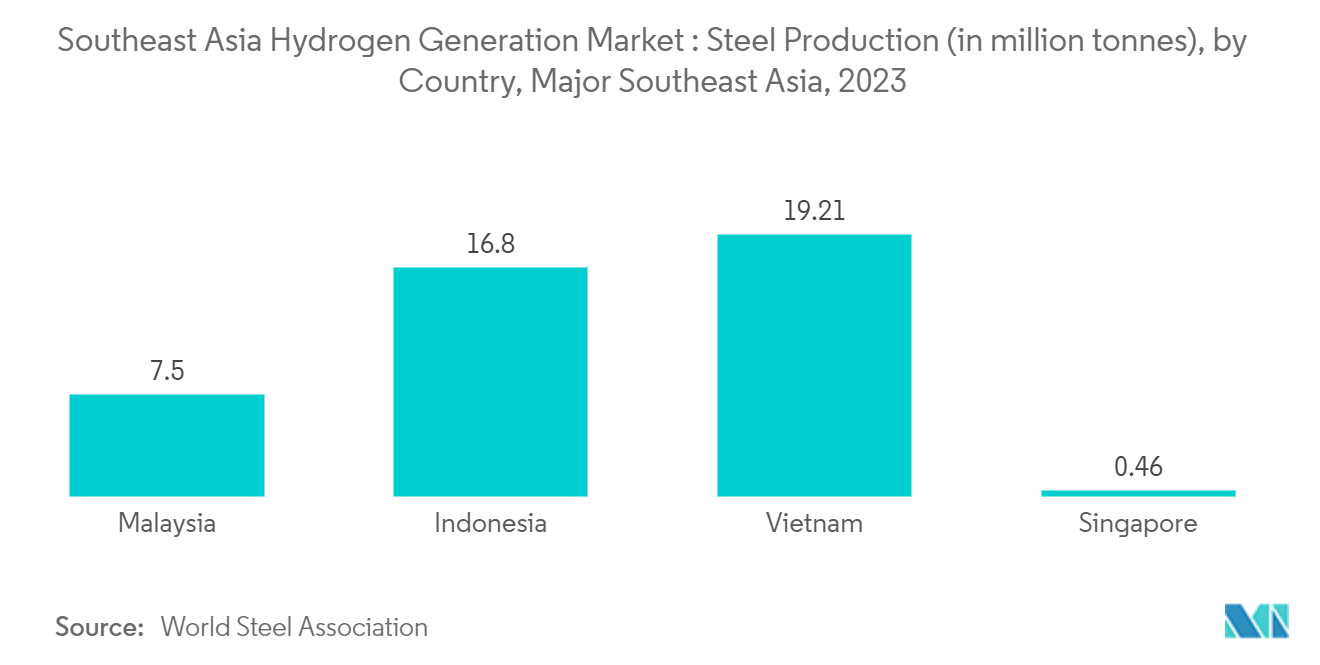
Indonesia to Witness Significant Growth
- As per the findings in the Indonesia Hydrogen Energy Outlook 2024, by 2060, hydrogen demand in Indonesia is expected to increase to around 2 million tonnes per annum (MTPA) due to increasing demand for Ammonia.
- PT Kilang Pertamina Internasional planned to construct a blue ammonia facility in Bintuni Bay, West Papua Province. The plant is expected to commence operations in 2030, aiming for a blue ammonia production capacity of around 875,000 TPA (tons per annum) of blue ammonia, which is expected to create a demand for blue hydrogen of around 150,000 TPA. The facility is designed to process 90 million standard cubic feet per day (MMSCFD) of natural gas.
- Several nations have started to push research into using hydrogen as an energy source since it has emerged as one of the most promising alternatives to carbon-intensive fuels. A Memorandum of Understanding for a long-term land lease to develop a solar-based green hydrogen production and export facility was signed in October 2022 by Carbon Governance Pte Ltd, a Singapore-based green energy project development company, with a local partner company in Bintan, Indonesia. The export of green hydrogen to Southeast Asia is anticipated to start in the first quarter of 2027, with the Bintan Green Hydrogen project scheduled to attain FID in the fourth quarter of 2023. All these developments/upcoming projects will likely positively impact hydrogen generation in Indonesia during the forecast period.
- Indonesia still needs to establish the required laws and policies to advance its green hydrogen sector. As of right now, just a few pilot projects are using green hydrogen for testing purposes. In any case, Green Hydrogen is believed to be essential to Indonesia's goal of becoming an emission-free nation by 2060. Green hydrogen is a sustainable energy source that is referenced in Indonesia's general national energy plan (RUEN) despite the need for official key policy papers for its development. In addition, the Indonesian Ministry of Energy and Mineral Resources' current renewable energy roadmap indicates that the country's power industry will progressively introduce green hydrogen development starting in 2031 and swiftly accelerate it beyond 2050.
- Steel production in Indonesia is increasing very rapidly. This is another primary reason behind the growth of hydrogen in Indonesia. Hydrogen provides sufficient energy and reduces the cost of steel manufacturing.
- Therefore, based on the above-mentioned factors, Indonesia is expected to witness significant growth in the Southeast Asia hydrogen generation market during the forecast period.
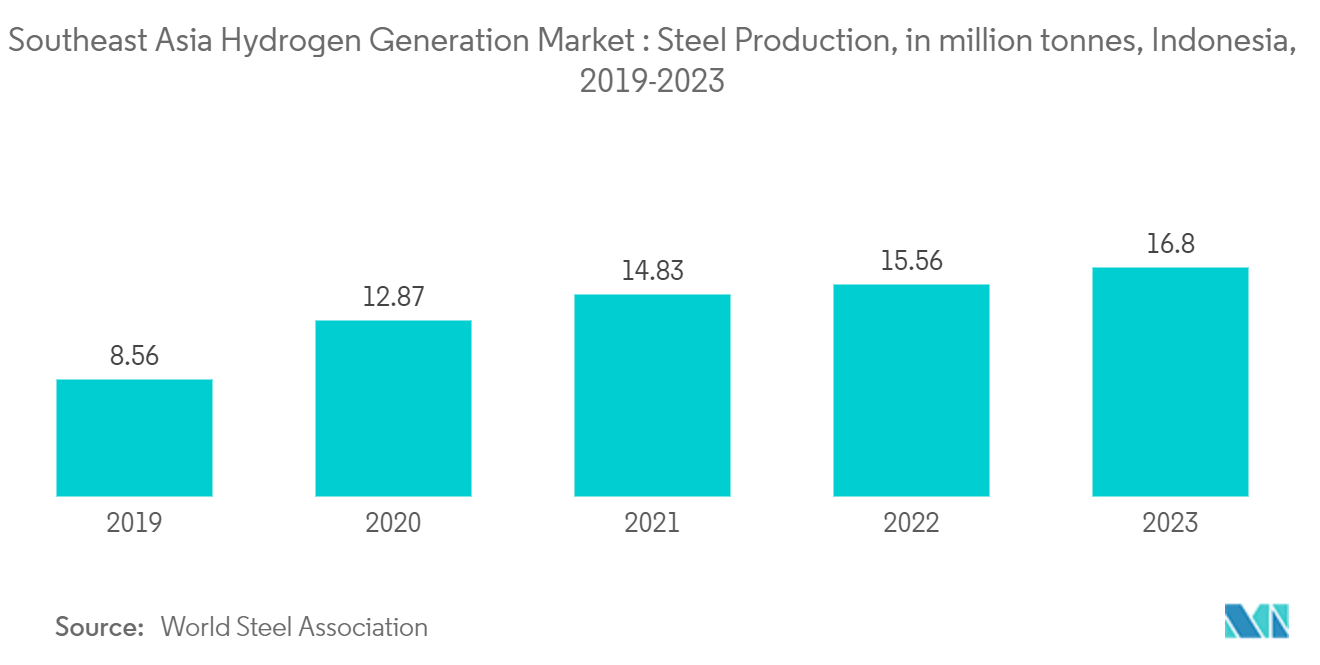
Southeast Asia Hydrogen Generation Industry Overview
The Southeast Asia hydrogen generation market is consolidated. Some of the major players in the market (in no particular order) include Linde Plc, Air Liquide SA, Messer Group GmbH, Engie S.A., and Cummins Inc., among others.
Southeast Asia Hydrogen Generation Market Leaders
-
Linde Plc
-
Air Liquide SA
-
Messer Group GmbH
-
Engie S.A.
-
Cummins Inc.
*Disclaimer: Major Players sorted in no particular order
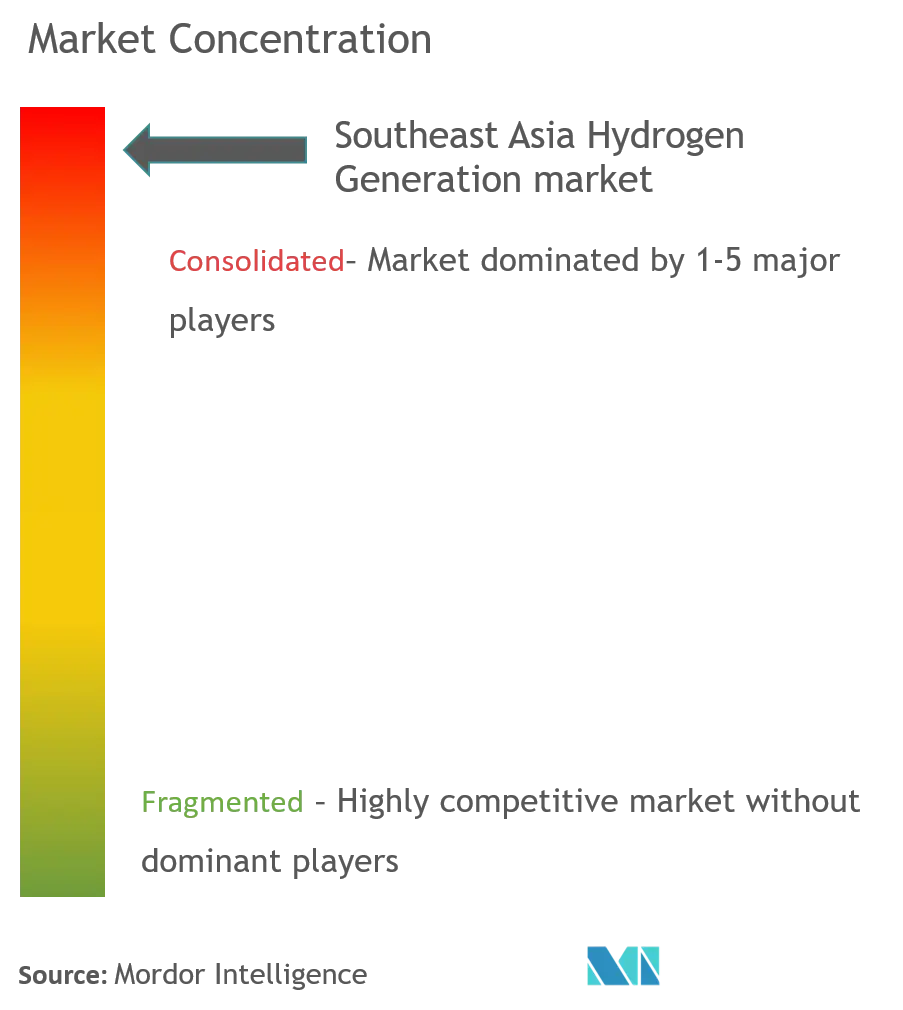
Southeast Asia Hydrogen Generation Market News
• In March 2024, Senayan Hydrogen Refueling Station Indonesia is going to get green hydrogen from PT PLN (Persero) after its 22nd Green Hydrogen Plant (GHP) is finished and built at the new renewable energy (EBT) facility. A total of 203 tons of green hydrogen are produced annually by PLN, which now operates 22 GHPs throughout Indonesia. The GHP in Kamojang is anticipated to provide about 4.3 tons of green hydrogen annually.
• In August 2023, Japan's Hydrogen and Derivatives Investments in Southeast Asia. Southeast Asia provides approximately 3 million metric tons of hydrogen, accounting for 3% of global hydrogen production. Although the region's largest hydrogen producer, it is primarily based on natural gas. Japanese companies have also signed deals to jointly develop low-carbon hydrogen production plants in Indonesia and Malaysia with Indonesian petrochemical company Panca Amara Utama and Malaysia's Petronas.
Southeast Asia Hydrogen Generation Market Report - Table of Contents
1. INTRODUCTION
- 1.1 Scope of the Study
- 1.2 Market Definition
- 1.3 Study Assumptions
2. EXECUTIVE SUMMARY
3. RESEARCH METHODOLOGY
4. MARKET OVERVIEW
- 4.1 Introduction
- 4.2 Market Size and Demand Forecast in USD billion, till 2029
- 4.3 Recent Trends and Developments
- 4.4 Government Policies and Regulations
-
4.5 Market Dynamics
- 4.5.1 Drivers
- 4.5.1.1 Increasing Demand From Refining And Industrial Sector
- 4.5.1.2 Favourable Government Policies
- 4.5.2 Restraints
- 4.5.2.1 High Capital Costs For Hydrogen Energy Storage
- 4.6 Supply Chain Analysis
-
4.7 Porter's Five Forces Analysis
- 4.7.1 Bargaining Power of Suppliers
- 4.7.2 Bargaining Power of Consumers
- 4.7.3 Threat of New Entrants
- 4.7.4 Threat of Substitutes Products and Services
- 4.7.5 Intensity of Competitive Rivalry
- 4.8 Investment Analysis
5. MARKET SEGMENTATION
-
5.1 Source (Qualitative Analysis)
- 5.1.1 Blue Hydrogen
- 5.1.2 Green Hydrogen
- 5.1.3 Grey Hydrogen
-
5.2 Technology
- 5.2.1 Steam Methane Reforming (SMR)
- 5.2.2 Coal Gasification
- 5.2.3 Other Technologis
-
5.3 Application
- 5.3.1 Oil Refining
- 5.3.2 Chemical Processing
- 5.3.3 Iron & Steel Production
- 5.3.4 Other Applications
-
5.4 Geography
- 5.4.1 Indonesia
- 5.4.2 Malaysia
- 5.4.3 Vietnam
- 5.4.4 Singapore
- 5.4.5 Rest of Southeast Asia
6. COMPETITIVE LANDSCAPE
- 6.1 Mergers and Acquisitions, Joint Ventures, Collaborations, and Agreements
- 6.2 Strategies Adopted by Leading Players
-
6.3 Company Profiles
- 6.3.1 Linde Plc
- 6.3.2 Air Liquide SA
- 6.3.3 Messer Group GmbH
- 6.3.4 Engie S.A.
- 6.3.5 Cummins Inc.
- 6.3.6 Air Products and Chemicals Inc.
- 6.3.7 Taiyo Nippon Sanso Holding Corporation
- 6.3.8 Enapter S.r.l.
- *List Not Exhaustive
- 6.4 Market Ranking/ Share Analysis
- 6.5 List of Other Prominent Companies
7. MARKET OPPORTUNITIES AND FUTURE TRENDS
- 7.1 Technological Advancements
Southeast Asia Hydrogen Generation Industry Segmentation
Hydrogen generation is an industrial process for generating hydrogen gas from diverse domestic resources, including fossil fuels, biomass, and water electrolysis with electricity. There are several processes to produce hydrogens, such as natural gas reforming/gasification, electrolysis, renewable liquid reforming, and fermentation.
The Southeast Asia hydrogen generation market is segmented by source, technology, application, and geography. By source, the market is segmented into blue hydrogen, grey hydrogen, and green hydrogen; by technology, the market is segmented into steam methane reforming (SMRR), coal gasification, and other technologies; by application, the market is segmented into oil refining, chemical processing, iron & steel production, and other applications and by Geography the market is segmented into Indonesia, Malaysia, Vietnam, Singapore, and Rest of Southeast Asia. For each segment, the market sizing and forecasts were made based on revenue capacity in USD.
| Source (Qualitative Analysis) | Blue Hydrogen |
| Green Hydrogen | |
| Grey Hydrogen | |
| Technology | Steam Methane Reforming (SMR) |
| Coal Gasification | |
| Other Technologis | |
| Application | Oil Refining |
| Chemical Processing | |
| Iron & Steel Production | |
| Other Applications | |
| Geography | Indonesia |
| Malaysia | |
| Vietnam | |
| Singapore | |
| Rest of Southeast Asia |
Southeast Asia Hydrogen Generation Market Research FAQs
How big is the Southeast Asia Hydrogen Generation Market?
The Southeast Asia Hydrogen Generation Market size is expected to reach USD 15.58 billion in 2024 and grow at a CAGR of 25% to reach USD 47.57 billion by 2029.
What is the current Southeast Asia Hydrogen Generation Market size?
In 2024, the Southeast Asia Hydrogen Generation Market size is expected to reach USD 15.58 billion.
Who are the key players in Southeast Asia Hydrogen Generation Market?
Linde Plc, Air Liquide SA, Messer Group GmbH, Engie S.A. and Cummins Inc. are the major companies operating in the Southeast Asia Hydrogen Generation Market.
What years does this Southeast Asia Hydrogen Generation Market cover, and what was the market size in 2023?
In 2023, the Southeast Asia Hydrogen Generation Market size was estimated at USD 11.69 billion. The report covers the Southeast Asia Hydrogen Generation Market historical market size for years: 2019, 2020, 2021, 2022 and 2023. The report also forecasts the Southeast Asia Hydrogen Generation Market size for years: 2024, 2025, 2026, 2027, 2028 and 2029.
Southeast Asia Hydrogen Generation Industry Report
Statistics for the 2024 Southeast Asia Hydrogen Generation market share, size and revenue growth rate, created by Mordor Intelligence™ Industry Reports. Southeast Asia Hydrogen Generation analysis includes a market forecast outlook for 2024 to 2029) and historical overview. Get a sample of this industry analysis as a free report PDF download.



